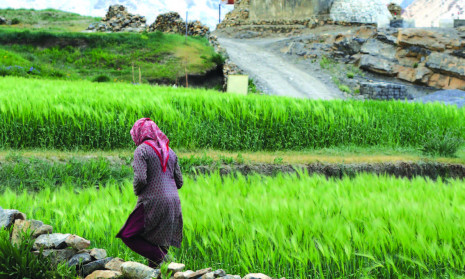Commentary

In March 2018, an account of a remarkable experiment involving millions of smallholder farmers in China was published in the journal Nature by Cui et al. (Nature 555, 363-66, doi 10.1038/nature25785; 2018).
The aim was to provide bespoke evidence-based advice to farmers on how to increase crop yields without the excessive use of fertilizers as has occurred in the past.
Over the past thirty years the yield and efficiency of agricultural production in China have increased dramatically. This has been a major factor underpinning the unprecedented growth in economic output and overall wellbeing in this vast country of over 1.4 billion people.
In many parts of the world where crop production has also increased, this has often been at the expense of smallholder farmers who might lack the expertise and/or resources to take full advantage of modern crop varieties. Another criticism that has been levelled against contemporary intensive farming is the increased use (and sometimes abuse) of chemicals, whether as fertilizers or as crop protection agents1.
In particular, the excessive or inappropriate use of nitrogenous fertilizers has led to well-documented cases of pollution of watercourses due to fertilizer runoff. This has certainly been a serious issue in China where the country makes up about 18% the global population, but accounts for 30% of total fertilizer use, meaning that its nitrogen footprint is among the largest in the world.
To quantify this, recent data from FAOSTAT show that on average Chinese farmers apply total fertilizer at a rate of 428 kg nutrients/ha, while the global average is only 115 kg/ha. Moreover, fertilizers in China have tended to be applied with an unbalanced N:P:K ratio that contained too much N for the amount of P and K used.
In the recent landmark Nature study, the project team of Chinese scientists spent a decade from 2005 to 2015 working with some 21 million smallholder farmers throughout the country. First, the scientists analysed huge amounts of data on crop planting density, soil type, irrigation, sowing depth, local climate etc in order to develop region-specific advice packages. Importantly, they also developed tailored crop-specific advice on optimal fertilizer application rates in each region ranging from the sub-tropical South to the semi-arid Loess Plateau region that was once one of the most productive farming regions in China.
The scientists then used a vast network of 65,000 local officials and 140,000 industry representatives to reach out to the 21 million farmers who cultivated almost 38 million hectares. To put this in context, the entire arable land area of the UK is only 6 million hectares.
The results of this enormous undertaking were quite striking. Not only did the smallholder farmers achieve an increase of 11% in rice, maize and wheat yields, they also reduced fertilizer use by 15-18%, depending on the crop.
The farmers also spent less money on managing their crops while getting increased profits due to the higher yields and reduced input costs. No new crop varieties were used in the study so the very significant economic and environmental benefits were entirely due to the provision of good relevant scientific advice, coupled with an excellent comprehensive extension network that won the willing cooperation of the millions of farmers involved.
Having seen the rather patchy record of providing modern crop breeding and management advice to small farmers via often poorly managed and funded extension services, it is clear to me that there are some important lessons to be learned from this study for global agriculture, especially in many developing countries.
1. Jia et al. (2014) Contribution of improved nitrogen fertilizer use to development of a low carbon economy in China, World Agriculture #1413, http://www.world-agriculture.net/article/contribution-of-improved-nitrogen-fertilizer-use-to-development-of-a-low-carbon-economy-in-china
Download pdf
